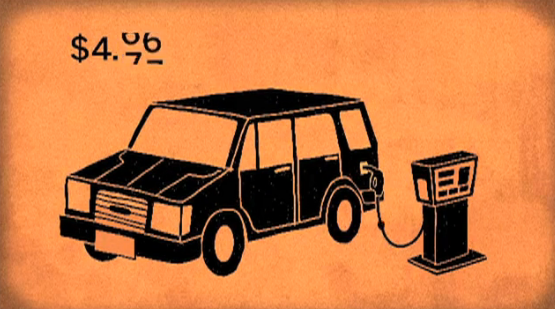What’s the true price of gasoline? This animated feature from the Center for Investigative Reporting explores the “external costs” of gasoline use in the U.S. — including pollution and the health problems caused by it. “The Price of Gas” video was reported by me, produced by Carrie Ching and Sarah Terry-Cobo, and illustrated by Arthur Jones:
California has some of the dirtiest air in the nation. Consequently, it has some of the strictest rules for gasoline, meaning it burns cleaner than it does in many other states. But cleaner fuels are more expensive.
Clean air requirements, combined with supply and refining constraints, make the price of California gas consistently among the highest in the nation. Turmoil in the Middle East is another factor that pushes up the global price of crude oil. Even though the average price for a gallon of regular unleaded gas in California fluctuates around $4, some experts argue that $4 a gallon is much less than the real cost.
 Compared with other industrialized countries, the U.S. has it cheap. The Economist notes that American consumers pay about half of what Europeans pay, which is up to about $8.50 per gallon (or $2.25 per liter). The media website Good has a nifty chart showing the disparity in prices across the Atlantic, and PBS’ NewsHour explains the effect Middle East turmoil has on the retail price of gas. While politicians on both sides of the aisle bicker about why gas is expensive, Sen. Jeff Bingaman, (D-N.M.), is one who explains the real reasons, and as David Roberts notes, he is lonely in doing so.
Compared with other industrialized countries, the U.S. has it cheap. The Economist notes that American consumers pay about half of what Europeans pay, which is up to about $8.50 per gallon (or $2.25 per liter). The media website Good has a nifty chart showing the disparity in prices across the Atlantic, and PBS’ NewsHour explains the effect Middle East turmoil has on the retail price of gas. While politicians on both sides of the aisle bicker about why gas is expensive, Sen. Jeff Bingaman, (D-N.M.), is one who explains the real reasons, and as David Roberts notes, he is lonely in doing so.
Even though reducing toxic chemicals in gasoline might make it more expensive, the EPA argues that clean air provides long-term cost benefits. A recent study of the Clean Air Act showed “the public health and environmental benefits … exceed their costs by a margin of four to one.”
From 1990 to 2010, these regulations have prevented “23,000 Americans from dying prematurely, [and] averted over 1,700,000 incidences of asthma attacks and aggravation of chronic asthma.” In the same two decades, it also prevented more than 4.1 million lost workdays due to pollution-related illnesses.
California is among the leaders in the U.S. in implementing clean-air regulations to limit pollution from carbon dioxide and other greenhouse gases. Its ambitious Global Warming Solutions Act aims to reduce greenhouse-gas pollution to 1990 levels by the year 2020 — goals similar to the United Nations’ Kyoto Protocol. And the state’s Air Resources Board will introduce the nation’s second pollution-trading system, known as cap-and-trade, for greenhouse gases on Jan. 1, 2012 (unless it can’t work out a lawsuit by October, as previously reported by California Watch). Under that system, if a company does not meet its pollution limits, it can buy a carbon offset, a promise to reduce pollution elsewhere.
But the market isn’t the only method the board is using to reduce air pollution and greenhouse gases. In fact, the board estimates only one-fifth of the reductions will come from cap-and-trade. The other four-fifths will come from increased energy-efficiency standards, improved recycling and composting programs, the highest standard for fuel efficiency in cars, and the state’s low-carbon fuel standard.
The cost of clean air programs may be high, but so is the cost of pollution. A 2008 study commissioned by CSU Fullerton’s Institute for Economic and Environmental Studies notes that the cost of air pollution for the greater Los Angeles region adds up to more than $1,250 per person per year.
For the Central Valley, where one-third of the nation’s produce originates, the cost is more than $1,600 per person per year. These costs include treatment for respiratory illnesses like asthma, which are disproportionately borne by children younger than 5, the elderly, and minority populations. Other costs include lost workdays, missed school days, and premature deaths.
But health effects are just some of the financial impacts of burning fossil fuels — gasoline and diesel fuel, in particular. Harmful air pollution can affect food and fiber crops. The U.S. Global Change Research Program noted in a 2009 report on climate change that greenhouse gases can reduce crop yields for “soybeans, wheat, oats, green beans, peppers, and some types of cotton.”
And the cost of oil spills? Some early estimates put the price of cleaning up the massive spill in the Gulf of Mexico at up to $20 billion. Every year, states spend more than $600 million to clean up leaking underground gasoline storage tanks.
In the last three decades, businesses, states, and the EPA have cleaned up 401,874 leaking underground gasoline storage tanks, with an estimated 93,123 more sites awaiting cleanup, according to an EPA representative. In 2010, the agency set aside $66.2 million in a fund for states to use for cleanup activities. The agency spends about $2 million to $3 million each year for cleanup on tribal land.
Although $4 a gallon may seem expensive, there are many social and environmental costs that Americans don’t pay for at the pump. While these costs are hidden, the cost to society is high.
This story was produced by California Watch for the Climate Desk Collaboration.



